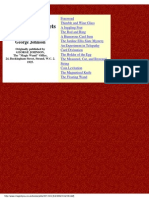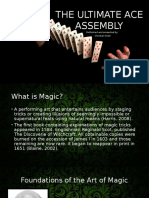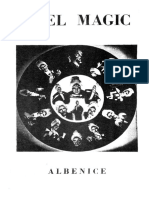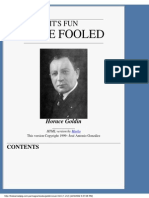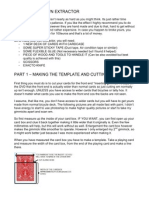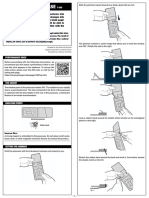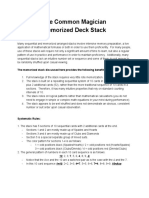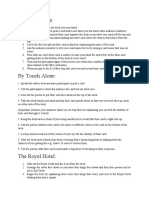Loius Christainer - Effective Tricks PDF
Loius Christainer - Effective Tricks PDF
Uploaded by
LBCopyright:
Available Formats
Loius Christainer - Effective Tricks PDF
Loius Christainer - Effective Tricks PDF
Uploaded by
LBOriginal Title
Copyright
Available Formats
Share this document
Did you find this document useful?
Is this content inappropriate?
Copyright:
Available Formats
Loius Christainer - Effective Tricks PDF
Loius Christainer - Effective Tricks PDF
Uploaded by
LBCopyright:
Available Formats
Effective Tricks--Cover
Contents
Foreword
~· ~ The Flag, Cone and Ball
The Mystic Number
The New Clock Trick
A Trick with Tissue
EFFECTIVE Paper
The Mandarin Sticks of
TRICKS Fung Chu
The Torn and Restored
--BY--
Napkin
LOUIS F. CHRISTIANER The Card and Orange
Trick
The Card and Envelope
~· ~ Tobacco, Water and
Silks
The Coin, Cards and
Glass
http://www.magic4you.co.uk/books/efftrcks/001.html [6/2/2002 8:44:03 AM]
Effective Tricks--Foreword
Effective Tricks
Louis F. Christianer
Next | Previous | Contents
Foreword
This little book is offered to magical entertainers with the sole purpose
of acquainting them with some of the effects that have been very
successful with the author, especially in club and drawing room
entertainments.
An especial endeavor has been made to make the various effects short
and clear in the description. Patter and other suggestions of "business"
have purposely been left out. These will be supplied upon request to
the author.
Other booklets are in active preparation, all of which will he
typographically uniform with the present one, and will contain much
that will be of interest to magical entertainers.
The author would earnestly suggest that readers of this book who
intend to make use of the effects, try to obtain other means of bringing
about the effect, thus adding a touch of originality which will often
mislead those who are acquainted with the author's method.
Next | Previous | Contents
http://www.magic4you.co.uk/books/efftrcks/002.html [6/2/2002 8:44:04 AM]
Effective Tricks--The Flag, Cone and Ball
Effective Tricks
Louis F. Christianer
Next | Previous | Contents
The Flag, Cone and Ball
This very pleasing combination will be found to be especially
effective when introduced at the end of a series of billiard ball moves.
The entertainer introduces a neat cardboard cone, a solid ball and a
small flag. The cone he places in a little stand on the table mouth up.
After a few moves, he drops the ball into the cone. Then he takes up
the flag and waving it in the air it changes into the ball, and the flag is
found in the cone in place of the ball.
There is no preparation about the cone, other than that it is nicely
made and decorated. Two flags, a solid ball, a hollow ball and a half
shell are also needed. The half shell is prepared as shown in Fig. "B."
Two small chips of wood, as "1" and "2," are glued to the inside of the
shell, so they project up about a sixteenth of an inch and are exactly
opposite each other. Now a small rubber band is stretched from one
chip to the other. One of the flags is then folded up and placed in the
shell, and prevented from springing out by the rubber band.
The shell is vested in the front and the hollow ball is also vested on the
left side. The solid ball and remaining flag are on the table with the
cone.
The cone is shown and placed in the little stand, mouth up. The solid
http://www.magic4you.co.uk/books/efftrcks/003.html (1 of 2) [6/2/2002 8:44:05 AM]
Effective Tricks--The Flag, Cone and Ball
ball is taken up and one or two moves gone through, after which you
pretend to place the ball in your mouth, pretend to swallow it and
produce it from the vest. You really palm the solid ball and the shell is
produced from the vest, and held so it appears as the solid ball. Now
you drop the shell, which the audience think is the ball, in the cone, in
such a way that it will turn with the flag up when it settles in the cone.
During this you have time to drop the solid ball in your pocket.
Then while picking up the flag with the right hand the left hand gets
the hollow ball, and the flag is gradually worked into the ball, which is
shown. Now with the thumb and first finger of the right hand you
reach into the cone and get the flag, which disengages the rubber, and
with a slight pressure you cause the shell to stick so it will not come
out with the flag.
By having the inside of the shell and the cone black, you are able to
show the cone empty after producing the flag. The shell is easily
constructed and the whole outfit will only cost a few cents and is as
good a trick as could be desired.
Next | Previous | Contents
http://www.magic4you.co.uk/books/efftrcks/003.html (2 of 2) [6/2/2002 8:44:05 AM]
Effective Tricks--The Mystic Number
Effective Tricks
Louis F. Christianer
Next | Previous | Contents
The Mystic Number
The effect of this fine trick, which was originated by Thayer, is as
follows: A deck of cards is thoroughly shuffled, after which a card is
selected and replaced in the deck, which is then squared up and placed
on the table.
Four cards are then thrown out haphazardly on the table and one is
chosen. The number of spots on this card is then to denote how far
from the top the selected card is to appear. Upon counting down from
the top, the selected card is found at this number.
The method of working this effect is as follows: After the deck is
mixed up, the performer gets a glance at the bottom card of the deck,
which is placed on the table. A spectator is then told to cut the cards,
and take any card from the deck and replace it on top of the first cut
(or what was at first the top card), and then place the other half on top
of this. This move brings the known bottom card on top of the card
selected. A number of cuts may then be made without any chance of
losing the card selected.
Now the entertainer runs through the deck, "to show that the card is
still there," and when he sees the card he noted on the bottom he
knows that the next card to the bottom of the deck is the one selected,
and then he runs eight more cards on top of the selected one, which
will make that card the ninth, and the others he removes to the bottom
of the deck. The card selected is now the ninth card from the top.
The performer then picks out four cards apparently in a haphazard
manner, but taking care that one of them is a nine. These four cards
are thrown on the table so they form two rows with the nine in the
right-hand lower corner.
The spectator is then told to touch either the top or bottom row of the
four cards. If he touches the row that does not contain the nine, just
move that row to one side. If he does touch the one with the nine,
move the other row to one side. Then have him select one of the two
remaining cards. If he does not take the nine, move that card away and
leave the nine. If he takes the nine, keep it and move the other away.
In any case the nine will still be on the table.
After impressing upon the minds of the spectators that no one has seen
http://www.magic4you.co.uk/books/efftrcks/004.html (1 of 2) [6/2/2002 8:44:05 AM]
Effective Tricks--The Mystic Number
the card on the table and no one but the person choosing same knows
what the card selected is, the performer states that he will cause the
selected card to appear at the same number from the top as the number
of spots on the card show.
As the selected card is already ninth from the top, the trick is already
done, but due dramatic actions must be gone into before showing that
your commands have been obeyed.
Next | Previous | Contents
http://www.magic4you.co.uk/books/efftrcks/004.html (2 of 2) [6/2/2002 8:44:05 AM]
Effective Tricks--The New Clock Trick
Effective Tricks
Louis F. Christianer
Next | Previous | Contents
The New Clock Trick
The entertainer introduces a neat little mantel clock of the oblong variety, as
well as a plain wooden box. He places the clock in the box, and places same
on his table. He next borrows a hat and places it mouth down on a table. He
then commands the clock to leave the box and travel to the hat. On opening
the box the clock has vanished and is found under the hat.
First purchase a clock after the style of the one shown in the drawing. Then
have a tinsmith make a duplicate with a removable lid. To the back of the
fake clock you fix the different wheels, and on the face place the dial and
glass over same. On either side of the face a small slit is made as at "A" and
"A2."
The box is made of thin mahogany with a removable lid, and of a size to hold
the clock snugly. The lid of this box is also faked to the extent of having two
small catches at either side, as at "B" and "B2." The depth of the box is such
that the face of the clock is allowed to project out just enough for the slits in
the side to clear the edge of the box.
To work the trick, place the real clock on the servante of your table. The box
and clock are resting on top of the table. Borrow a derby hat and rest it on a
chair. Now take up the fake clock and show it from all sides and place it in
the box with the back first. Now place on the lid of the box and while doing
so press the catches on the sides so they will engage in the slits of the face of
the clock. Now go to table and set hat on same, immediately lifting the hat to
prove there is nothing under same and load the real clock at the same time.
Then rest hat mouth down on table.
http://www.magic4you.co.uk/books/efftrcks/005.html (1 of 2) [6/2/2002 8:44:06 AM]
Effective Tricks--The New Clock Trick
All that is necessary then is to open box and as the inside of the box and clock
are black the box seems empty, as the face of. the clock is brought off with
the lid of the box. Show clock under hat and return the hat to owner.
An effective combination would be to vanish a handkerchief and find it in
place of the clock in the box and the clock under the hat.
Next | Previous | Contents
http://www.magic4you.co.uk/books/efftrcks/005.html (2 of 2) [6/2/2002 8:44:06 AM]
Effective Tricks--A Trick with Tissue Paper
Effective Tricks
Louis F. Christianer
Next | Previous | Contents
A Trick with Tissue Paper
The following very effective version of the Torn and Restored strip of
paper, has always been a favorite of mine, and although nothing new
is offered, the manner of working will no doubt be of interest to those
who use this effect.
A small quantity of red, white and blue confetti is formed in a ball and
wrapper in a piece of white tissue paper. One corner of the paper is
left projecting so it may be inserted in a fold of a fan. This is placed on
your table, upon which you have a glass of water and three squares of
paper, red, white and blue, about eight inches square.
Previously you have prepared a long strip of paper, by pasting a red,
white and blue strip end to end, forming one long strip. This is folded
accordeon fashion and inserted in the thumbtip and placed on your
right thumb. You are now ready for the trick.
After showing the hands empty in a casual manner, you take up the
three squares of tissue paper and placing them together, tear off a strip
about an inch in width. These strips you show separately, then place
them together, tear them into small bits, just as you would work the
regular form of this effect. The pieces are then rolled into a small ball,
and substituted for the long strip in the tip, the pieces taking its place
and the tip placed back on the thumb. No space will be taken to
explain this change as every performer has his own method and ample
instructions come with the tip when purchased from a dealer.
The long strip is then pulled out showing the pieces restored and
formed in one long strip, the hands otherwise being empty. You now
tear the long strip into small pieces and picking up the glass with the
right hand, dropping the thumb tip in a well at the same time, you drop
the pieces in the water. Now place the glass in the left hand and with
the right hand take up the fan by the end that opens, grasping the ball
of confetti at the same time. With the other end you take the wet
pieces of paper out of the glass and place the glass on the table. Now
transfer the fan and with it, the ball of confetti to the left hand, while
the right hand takes the wet pieces off the end of the fan and squeezes
the water out, making a small ball. These pieces are apparently placed
in the left hand, while the right takes the fan out of the hand, which
hides the wet ball and opening the fan begins to fan the left hand. The
http://www.magic4you.co.uk/books/efftrcks/006.html (1 of 2) [6/2/2002 8:44:07 AM]
Effective Tricks--A Trick with Tissue Paper
left hand gradually breaks the tissue paper covering the confetti and
allows the confetti to fly out of the hand, the white covering being
worked into a bail and dropped with the flying pieces.
"Magicians Tricks" by Hatton & Plate, have both of these effects
explained, offering different methods, and if the performer will glance
through this book he will be able to arrange an original method, and
will be rewarded by having a fine little trick suitable for most any
occasion.
Next | Previous | Contents
http://www.magic4you.co.uk/books/efftrcks/006.html (2 of 2) [6/2/2002 8:44:07 AM]
Effective Tricks--The Mandarin Sticks of Fung Chu
Effective Tricks
Louis F. Christianer
Next | Previous | Contents
The Mandarin Sticks of Fung Chu
The entertainer
introduces two short
sticks, artistically
decorated in Chinese
characters, which he
says are "similar to
those used by the
famous Mandarin of
Fung Chu when he
desired one of his four
wives to wait upon
him." Hanging to one
side is a series of
Dinner Chimes and the
entertainer strikes the
chimes with the sticks,
being, he explains, the
method used by the
Mandarin. He then
wraps the sticks in
Chinese paper, and
suddenly crushes the
paper, the sticks having
vanished.
It will readily be seen that this effect is nothing more than an
enlargement on the old vanishing wand effect. In this case the sticks
are shells with wooden plugs at either end, the one end being
fashioned to represent the end of the solid stick. These two solid
sticks, which are an exact duplicate of the fake ones, are in the vest
pockets.
The fact that the entertainer strikes the chimes with the sticks is
enough to proclaim them solid, whereas a little atmosphere is lent to
the trick by having the sticks made of decorated Chinese paper and by
using the chimes.
The chimes I have used were very musical and by using "China
Chinatown," a popular song, as an opening piece, a pretty effect was
http://www.magic4you.co.uk/books/efftrcks/007.html (1 of 2) [6/2/2002 8:44:08 AM]
Effective Tricks--The Mandarin Sticks of Fung Chu
created. The entertainer will of course tell a little fairy story. Space
prevents doing so here, but if it is desired I will be glad to send the
patter used by myself for this effect.
Next | Previous | Contents
http://www.magic4you.co.uk/books/efftrcks/007.html (2 of 2) [6/2/2002 8:44:08 AM]
Effective Tricks--The Torn and Restored Paper Napkin
Effective Tricks
Louis F. Christianer
Next | Previous | Contents
The Torn and Restored Paper Napkin
The effect of tearing a paper napkin into small pieces and then
restoring it has become very popular lately. The following is no
different as far as the effect is concerned, but the methods employed
might be of interest.
Five paper napkins are required for the trick. One of these is rolled
around one end of your wand after the manner of the handkerchief
production. Three are placed in full view on your table. A
handkerchief placed carelessly on the table hides the napkin on the
wand.
The remaining napkin is rolled into a small ball about the size of the
small billiard ball. A piece of fine black wire is then twisted around
this ball and formed into a loop large enough to pass the thumb
through.
On the right side of your coat, just inside the lapel, you have a small
loop of thread which will hold the napkin ball securely, but still allow
it to be withdrawn when the thumb is placed in the wire loop. With the
napkin ball in this loop you are ready to work the trick. Be sure to
have the wire loop from the napkin project straight out, so you can
easily insert the thumb.
Come forward and show the hands empty. Take up a napkin and tear it
into small pieces, showing the hands empty at all times. Finally the
pieces are rolled into a small ball and placed in the left hand, which
holds them at arm's length. The right hand then passes across the
breast, the thumb engages in the wire loop and the napkin comes into
the right palm very readily. You give the pieces another squeeze,
which disengages the wire loop, exchange the whole napkin for the
pieces, which are at once palmed in the right hand, and you open the
napkin, showing it restored. Finally roll the napkin into a ball and with
it the pieces and throw to one side.
You then undertake to explain the trick. Roll a napkin into a ball and
openly place it in the left palm. Now take the other napkin and tear it
up and roll the pieces into a ball. You then pretend to change the
pieces for the ball in your palm, explaining that that is what you do. In
reality the pieces are held at the tips of the fingers of the left hand and
http://www.magic4you.co.uk/books/efftrcks/008.html (1 of 2) [6/2/2002 8:44:09 AM]
Effective Tricks--The Torn and Restored Paper Napkin
the whole napkin in the palm. Then take up the wand, the fingers of
the right hand hiding the napkin at the end. Touch the ball at finger
tips with same and place wand under your left arm, retaining the
napkin which was rolled around the end in the right hand. Now you
give the pieces an extra squeeze, make the change, take wand again in
right hand, which hides the pieces concealed there, and place wand on
table, dropping the pieces in a well as you do so.
Now open the napkin at the finger tips and show restored. Of course,
having seen you make the change the audience think the pieces are in
the palm. This you open and show whole and the laugh is on the
audience.
Try this method a few times and I am sure you will be gratified with
the results obtained.
Next | Previous| Contents
http://www.magic4you.co.uk/books/efftrcks/008.html (2 of 2) [6/2/2002 8:44:09 AM]
Effective Tricks--The Card and Orange Trick
Effective Tricks
Louis F. Christianer
Next | Previous | Contents
The Card and Orange Trick
This trick ranks with the Bill and Lemon trick or the Card in the Egg
trick in effect, and has the advantage of the tricks mentioned in that it
is easier to do.
A card is selected and retained. An orange is handed around for
inspection, after which it is placed on the table. Next the card is torn
into small bits, the pieces placed in a small box and the box wrapped
in a handkerchief. Regardless of this, the pieces, with the exception of
one corner, leave the box and are found in the center of the orange.
First tear a comer off a card and roll the card into a small roll, like a
cigarette. The little piece of the stem of the orange is removed, then
with a sharp knife the center pith of the orange taken out. This leaves a
hole large enough to force the card down in, after which the pith and
piece of the stem are replaced. In this condition the orange will stand
any amount of examination.
Two small wooden boxes a trifle larger than a half dollar are required.
In one of these boxes the corner of the card is placed, and this box
placed in the right coat pocket. The other box is placed on the table,
together with the orange and a deck of cards with a duplicate card of
the one in the orange on romp. A rubber band in the pocket with the
box and a handkerchief complete the arrangement.
The performer forces the duplicate card. m simple method to do this is
to have the card seventh from the top. Anyone is then asked to call out
a number between one and ten. Almost always seven is chosen, but if
not it is easy for the performer to pass the required number from the
top or add to the top as desired. Therefore the card is forced and
retained. Next the orange is given out, and after handled as much as
the audience wish, it is placed on the table.
Now the box is taken from the table and given to the person who
chose the card and requested to tear up the card and place the pieces in
the box. While this is being done you have ample time to palm in the
right hand the duplicate box and also remove from the pocket the
handkerchief. Hold the handkerchief by the tips of the fingers of both
hands, then you take the box from the person with the right hand, the
hand containing the palmed box. The left hand then throws the
http://www.magic4you.co.uk/books/efftrcks/009.html (1 of 2) [6/2/2002 8:44:09 AM]
Effective Tricks--The Card and Orange Trick
handkerchief over the box, and this same hand at once takes the
palmed box, while the box containing the pieces is allowed to fall into
the palm. The right hand then goes into the pocket for the rubber band,
leaves the palmed box behind, and places the band around the box in
the handkerchief, which is then given to someone to hold. The effect
to the audience is that you placed the box containing the pieces in the
handkerchief, placed a rubber band around it and gave it to someone
to hold. This principle is the same as the well-known billiard ball
change in handkerchiefs.
Now you command the card to unite and to pass from the box into the
orange. Then cut open the orange and find the card restored with the
exception of one piece, and on opening the box you find the missing
corner. This trick is always met with great astonishment from the
audience and is well worth the small amount of preparation. I have
also used a nest of two boxes with great success, the method being
exactly the same.
Next | Previous| Contents
http://www.magic4you.co.uk/books/efftrcks/009.html (2 of 2) [6/2/2002 8:44:09 AM]
Effective Tricks--The Card and Envelope
Effective Tricks
Louis F. Christianer
Next | Previous | Contents
The Card and Envelope
The following little effect, although offering nothing new in the way
of sleights, is sufficiently effective for those who are good at making
the top change with cards, to warrant them perfecting this move.
While standing around the table, as at the club, you are asked to do a
trick. A pack of cards is shuffled and one selected and returned to the
deck. A second card is drawn and laid on the table. An envelope is
examined and the performer places the selected card on the table
therein, and seals it, the card we will say, is the six of hearts. Taking
up the deck it is shuffled and suddenly dropped on the envelope, and
there face up on the deck is the six of hearts, while in the envelope is
found the first selected card.
The first card selected is brought to the top of the deck by means of
the pass. The second card is drawn and the performer takes it and
places it on the table, during which move the top change is made and
the first card placed on table face down and the second left on the top.
The working is then apparent. Instead of the second selected card, the
first one is the card to go into the envelope, while the other card is
caused to turn over by means of the well known reverse. Of course the
performer will have to make his moves according to his ability to
make the top change. This change is one of the writer's favorite
moves, and the trick exactly as described always creates a deep
impression. Mr. Downs, in the "Art of Magic," in describing the
"General Card" explains a fine change which may also be used to
good advantage in this trick.
Next | Previous| Contents
http://www.magic4you.co.uk/books/efftrcks/010.html [6/2/2002 8:44:10 AM]
Effective Tricks--Tobacco, Water and Silks
Effective Tricks
Louis F. Christianer
Next | Previous | Contents
Tobacco, Water and Silks
For an effective combination for club work, the following would be
hard to beat. The entertainer introduces a Tuxedo tobacco can and
empties the tobacco into a glass. Some water is then poured into the
can, and three handkerchiefs vanished and reproduced from the can
perfectly dry, after which the water is poured out. The cover is then
placed on the can, and a tube placed over the glass of tobacco. Liftlng
the tube, the tobacco has vanished and found in the can as at the start.
The can is an
ordinary
Tuxedo can,
to the center
of which has
been affixed a
shaving stick
holder with a
lid. The
whole inside
of the can is
then painted
black. The lid
which comes with the can is then faked by having an inner lid made so
that when the real lid is placed on the can and taken off this inner lid is
then on the can, as in Fig. 2.
The glass to vanish the tobacco has a celluloid lining and can be easily
procured at any dealer's.
To prepare for the trick, three silks are loaded in the can and then a
little tobacco placed in same. Some loose tobacco is placed in the
inner lid of the can, which is then placed in the real lid and rested
gently on the can. Three duplicate silks and a pull are all that is
needed, as well as pitcher of water.
You proceed to pour out the tobacco from the can into the glass, after
which you twirl the can on your wand and otherwise prove it empty.
Then pour some water into the can. The three silks are then taken up
and caused to vanish by working into the pull. The performer then
holds the can on his left hand while with the right reaches in and opens
http://www.magic4you.co.uk/books/efftrcks/011.html (1 of 2) [6/2/2002 8:44:11 AM]
Effective Tricks--Tobacco, Water and Silks
the lid of the can and takes out the silks one at a time, after which the
water is poured out of the can into the pitcher. Now place the lid on
the can tight, cover the glass of tobacco which has the celluloid lining
with the tube, lift up tube and drop the load in a well, showing the
tobacco vanished. Take lid off can, leaving the inner one showing
tobacco returned.
Next | Previous | Contents
http://www.magic4you.co.uk/books/efftrcks/011.html (2 of 2) [6/2/2002 8:44:11 AM]
Effective Tricks--The Coins, Cards and Glass
Effective Tricks
Louis F. Christianer
Previous | Contents
The Coins, Cards and Glass
The following effective trick is the idea of Mr. S. H. Robinson, a very
clever performer. It is his method of performing a well known version
of the coin through the deck of cards into a glass, a description of
which will be found in Roterberg's "New Era Card Tricks,"
The performer places a deck of cards on top of a glass and then covers
the whole thing with a handkerchief. Holding the glass in this
condition in his left hand, he takes up a coin in the right and makes a
throwing move towards the glass, when the coin is seen to leave the
right hand and heard to fall into the glass, where it is found.
The performer has a duplicate coin finger palmed in the right hand.
The deck of cards is passed from the left hand to right hand and upon
the coin palmed therein. Showing a glass the cards are placed upon the
top of same so the coin will be held between the cards and edge of the
glass. A slight pressure in the middle of the cards causes a slight
depression and holds them in place. Now throw a handkerchief over
the cards and gather it together at of the glass, after which you grasp
the glass from the top, holding the cards at the same time.
The right hand takes up a coin and in the move of throwing it to the
glass, palms it and the left hand presses on the edge of the cards and
causes the coin to drop in the glass. The glass is at once placed in the
right hand, hiding the coin palmed there, the handkerchief and cards
taken off the glass and the coin emptied into the left hand. This little
effect is fine to insert in a series of coin and card tricks and on account
of its very simplicity is all the more appreciated.
according to his ability to make the top change. This change is one of
the writer's favorite moves, and the trick exactly as described always
creates a deep impression. Mr. Downs, in the "Art of Magic," in
describing the "General Card" explains a fine change which may also
be used to good advantage in this trick.
Previous | Contents
http://www.magic4you.co.uk/books/efftrcks/012.html [6/2/2002 8:44:11 AM]
You might also like
- Citadels Card GameDocument26 pagesCitadels Card GameDamiano Lozzi100% (5)
- Swoop RulesDocument2 pagesSwoop RulesMax Byers0% (2)
- ACES AND KINGS - by Henry Christ (Trick)Document3 pagesACES AND KINGS - by Henry Christ (Trick)Paul Ham100% (1)
- Steve Fearson - Thumbthing PDFDocument8 pagesSteve Fearson - Thumbthing PDFsq100% (1)
- Richard Kauffman Coin Magic PDF: AMAZING MIRACLES OF SHIGEO TAKAGI - 1990 First Edition - H, Richard Kaufman, 24Document1 pageRichard Kauffman Coin Magic PDF: AMAZING MIRACLES OF SHIGEO TAKAGI - 1990 First Edition - H, Richard Kaufman, 24fede29% (7)
- Karl Fulves - Easy-To-Do Card Tricks For ChildrenDocument41 pagesKarl Fulves - Easy-To-Do Card Tricks For ChildrenpinguetNo ratings yet
- NotionOfMotion_OriginalInstructionsDocument36 pagesNotionOfMotion_OriginalInstructionsbarumjeffries100% (1)
- Old Wine in a New Bottle: Classic Card Tricks Spectacularly Re-WorkedFrom EverandOld Wine in a New Bottle: Classic Card Tricks Spectacularly Re-WorkedNo ratings yet
- Al Baker's Books of Magic Tricks - Book One & TwoFrom EverandAl Baker's Books of Magic Tricks - Book One & TwoRating: 2.5 out of 5 stars2.5/5 (2)
- Houdini's Card Tricks - Teach Yourself the Tricks of the World's Most Famous MagicianFrom EverandHoudini's Card Tricks - Teach Yourself the Tricks of the World's Most Famous MagicianNo ratings yet
- Peerless Prestidigitation Being a collection of entirely new ideas and effects in the fascinating art of modern magicFrom EverandPeerless Prestidigitation Being a collection of entirely new ideas and effects in the fascinating art of modern magicNo ratings yet
- The Boy Magician: A large number of the latest and best tricks carefully selected for the rising generation of conjurersFrom EverandThe Boy Magician: A large number of the latest and best tricks carefully selected for the rising generation of conjurersNo ratings yet
- Greorge Johnson - A Few Jardine Ellis SecretsDocument23 pagesGreorge Johnson - A Few Jardine Ellis SecretsClsalesNo ratings yet
- Frank Chapman - Three Six Bits PDFDocument16 pagesFrank Chapman - Three Six Bits PDFBabrikowski LucasNo ratings yet
- BackstoryDocument24 pagesBackstorygiacomoNo ratings yet
- Marked Fake Deck Tricks4Document6 pagesMarked Fake Deck Tricks4Tito Banerjee100% (1)
- Learned Pig - My Stuff PDFDocument75 pagesLearned Pig - My Stuff PDFLB100% (1)
- Daniel Garcia Project - ToCDocument3 pagesDaniel Garcia Project - ToCDonGreedy100% (2)
- Anon - A Knotty Routine PDFDocument9 pagesAnon - A Knotty Routine PDFLeah ArnoldNo ratings yet
- Learn Sponge BallsDocument3 pagesLearn Sponge BallsFrederick PérezNo ratings yet
- Liam Montier - PandoraDocument26 pagesLiam Montier - Pandorajavitenorio Javier100% (1)
- Spread Wave RussianDocument17 pagesSpread Wave RussiankaroNo ratings yet
- Blue Gaff Deck: Parade of The KingsDocument14 pagesBlue Gaff Deck: Parade of The KingsMagicMan100% (2)
- Rick Carruth Editor/publisher Compiled by Werner Miller: Match Magic - EffectDocument37 pagesRick Carruth Editor/publisher Compiled by Werner Miller: Match Magic - Effecttrixter11793No ratings yet
- Chapter Four Mcdonald'S $100 Routine: EffectDocument5 pagesChapter Four Mcdonald'S $100 Routine: Effectmancinomagic100% (2)
- Ernest Noakes - Magical Originalities PDFDocument81 pagesErnest Noakes - Magical Originalities PDFPhilip Maxwell SeniorNo ratings yet
- The Ultimate Ace AssemblyDocument16 pagesThe Ultimate Ace Assemblytrixiarrrr100% (1)
- Albenice Reel Magic PDFDocument79 pagesAlbenice Reel Magic PDFJonatanSerranoNo ratings yet
- Horace Goldin QhoraceDocument179 pagesHorace Goldin QhoraceClsales100% (1)
- Bagshawe's - Proudlock's Egg Bag and Four Race PresentationsDocument28 pagesBagshawe's - Proudlock's Egg Bag and Four Race PresentationsMarco100% (1)
- Smells Like Ace by Nate KranzoDocument3 pagesSmells Like Ace by Nate KranzoNoNo100% (1)
- Double Lift SubstituteDocument1 pageDouble Lift SubstituteMagicManNo ratings yet
- Doug Edwards - Rubber BanditDocument4 pagesDoug Edwards - Rubber Banditfata123No ratings yet
- Magic MagazineDocument1 pageMagic MagazineJoe MckayNo ratings yet
- Labyrinth 1999Document1 pageLabyrinth 1999trixter117930% (1)
- Doug Edwards - The Drunken Master ShuffleDocument3 pagesDoug Edwards - The Drunken Master Shufflefata1230% (1)
- Ring On Rubber BandDocument4 pagesRing On Rubber Bandkaro100% (1)
- J R R B: Ack Irnman Obert Armer Ussell ArnhartDocument3 pagesJ R R B: Ack Irnman Obert Armer Ussell Arnhartjoe mckay100% (1)
- Magic Lessons - Brad BurtDocument32 pagesMagic Lessons - Brad BurtAnonymous zE7GEC1mX100% (1)
- Diy Cheep Three Coconut Hindu ShellDocument17 pagesDiy Cheep Three Coconut Hindu ShellGidion2013No ratings yet
- Revolutionary Card Technique TocDocument1 pageRevolutionary Card Technique Tocscribdman1No ratings yet
- John Kennedy - Card Thru Window PDFDocument2 pagesJohn Kennedy - Card Thru Window PDFBabrikowski Lucas100% (2)
- Shadow GraphyDocument17 pagesShadow Graphyselma_dragosNo ratings yet
- Will - Blyth. .Paper - Magic2Document7 pagesWill - Blyth. .Paper - Magic2Karanbir SinghNo ratings yet
- Peter Nardi - LA CONGA ESTA LOCADocument5 pagesPeter Nardi - LA CONGA ESTA LOCACaptaîn Moreland100% (1)
- Harold Sterling - No BottomsDocument9 pagesHarold Sterling - No BottomsPaul HamNo ratings yet
- Alex PandreaDocument5 pagesAlex PandreaMerryo Setyawan0% (3)
- DeVega - More Selected Secrets PDFDocument23 pagesDeVega - More Selected Secrets PDFLuigi-igiuLNo ratings yet
- Erdnase Bottom DealDocument2 pagesErdnase Bottom DealMichael Pascoe100% (1)
- Peter Duffie MagicDocument3 pagesPeter Duffie MagicsinisaNo ratings yet
- Tenyo Magic - Shocking Pass Case (2024)Document4 pagesTenyo Magic - Shocking Pass Case (2024)davidingsNo ratings yet
- Secret Letter #6 - 18th April 2020: Ask RobertoDocument10 pagesSecret Letter #6 - 18th April 2020: Ask RobertonarykNo ratings yet
- ESP DECK NEW - UkDocument1 pageESP DECK NEW - UkJose Luis LopezosaNo ratings yet
- MaskelyneDocument142 pagesMaskelyneClsales100% (1)
- 3 and A Half of Clubs CardDocument2 pages3 and A Half of Clubs CardChuckNo ratings yet
- Aldo Colombini - Aldo On Trost Vol. 1Document2 pagesAldo Colombini - Aldo On Trost Vol. 1paul murphyNo ratings yet
- Goshman - Multiplying Sponge BallsDocument2 pagesGoshman - Multiplying Sponge BallsPablo AtuanNo ratings yet
- Dust Pms5003 Laser Sensor: Guangzhou Logoele Electronic Technology Co., LTDDocument3 pagesDust Pms5003 Laser Sensor: Guangzhou Logoele Electronic Technology Co., LTDLBNo ratings yet
- Pilsen OC: Mash IngredientsDocument1 pagePilsen OC: Mash IngredientsLBNo ratings yet
- Belgian ChristmasDocument1 pageBelgian ChristmasLBNo ratings yet
- Stout OC: Mash IngredientsDocument1 pageStout OC: Mash IngredientsLBNo ratings yet
- Weizen OC: Mash IngredientsDocument1 pageWeizen OC: Mash IngredientsLBNo ratings yet
- Abadia Belga OC: Mash IngredientsDocument2 pagesAbadia Belga OC: Mash IngredientsLBNo ratings yet
- Barley WineDocument1 pageBarley WineLBNo ratings yet
- Golden StrongDocument2 pagesGolden StrongLBNo ratings yet
- Ipa Oc: Mash IngredientsDocument2 pagesIpa Oc: Mash IngredientsLBNo ratings yet
- Bob Farmer Genii 2004 02 ConSumer AlertDocument4 pagesBob Farmer Genii 2004 02 ConSumer Alertphilippos1979No ratings yet
- Golems Card Game RulesDocument8 pagesGolems Card Game RulesH V CNo ratings yet
- Csc10002 - Programming Techniques Midterm Project - PointersDocument6 pagesCsc10002 - Programming Techniques Midterm Project - PointersPhước Nguyên HoàngNo ratings yet
- Vocabulary U2 PDFDocument8 pagesVocabulary U2 PDFnugiviNo ratings yet
- 33.Orestium by PernaDocument99 pages33.Orestium by Perna1447182719johnsonNo ratings yet
- Masters of The Night RulebookDocument20 pagesMasters of The Night RulebookLazar T.No ratings yet
- The History of Playing Cards PresentationDocument13 pagesThe History of Playing Cards PresentationDustyNo ratings yet
- Redjak'S Automated Overlord Variant V4.0.7: Priority Sub-PriorityDocument8 pagesRedjak'S Automated Overlord Variant V4.0.7: Priority Sub-PriorityDiego J. Aracena OlivaresNo ratings yet
- Mentalist Tricks: Quick Tips For TrainingDocument26 pagesMentalist Tricks: Quick Tips For Trainingmagicchiu100% (1)
- Solo Scenario Book: 1. General PrinciplesDocument14 pagesSolo Scenario Book: 1. General Principlesdavid_baylón_1No ratings yet
- Dragonfire Cards V1.5Document153 pagesDragonfire Cards V1.5Armand Guerre100% (1)
- The Common Magician Memorized Deck Stack: PremiseDocument12 pagesThe Common Magician Memorized Deck Stack: Premisejaylen gardnerNo ratings yet
- Ultimate EffectDocument11 pagesUltimate EffectSantiago Bueno100% (1)
- Probability Complete ChapterDocument54 pagesProbability Complete ChapterKULDEEP SINGHNo ratings yet
- Hell of A Game RulesDocument5 pagesHell of A Game Rulesapi-525858524No ratings yet
- Reichbusters v1 22Document10 pagesReichbusters v1 22Joctan GutierrezNo ratings yet
- 4059.marcelo Insua - Some Cards Have A CurlDocument7 pages4059.marcelo Insua - Some Cards Have A CurlsalvadorNo ratings yet
- Magic TricksDocument3 pagesMagic TricksmbarbercatoNo ratings yet
- Scythe Prototype RulesDocument32 pagesScythe Prototype RulesJoseph HsuNo ratings yet
- Clear the Dungeon Complete 1.0.1Document3 pagesClear the Dungeon Complete 1.0.1kralkatorrikzgNo ratings yet
- Illimat Playtest Rules V1Document10 pagesIllimat Playtest Rules V1MieliNo ratings yet
- MEDUSA PLAYING CARDS With 7 Marking Systems by Antonio Cacace - KickstarterDocument49 pagesMEDUSA PLAYING CARDS With 7 Marking Systems by Antonio Cacace - KickstarterMarco ThrushNo ratings yet
- Illuminate Your Intuition GuidebookDocument42 pagesIlluminate Your Intuition GuidebooksonamNo ratings yet
- Final Primer 1Document39 pagesFinal Primer 1garoublade3984No ratings yet
- Decipher's Wars CCG - Strategy ArticlesDocument50 pagesDecipher's Wars CCG - Strategy ArticlesmrtibblesNo ratings yet
- Probability Simulation EnglishDocument9 pagesProbability Simulation EnglishBenjy SmithNo ratings yet
- Tarot Kabbalah 1Document7 pagesTarot Kabbalah 1HugoSalinasRiveraNo ratings yet
- House of Cards FullDocument149 pagesHouse of Cards FullMichael Seth KahanNo ratings yet

















